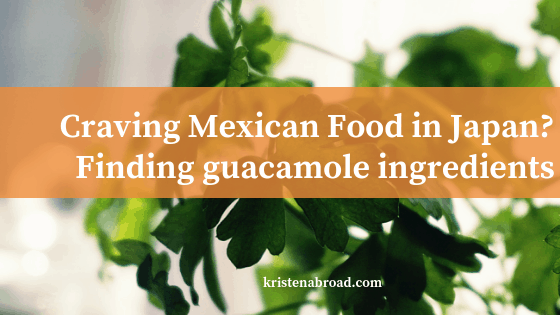Fun internet find of the day – how to find guacamole ingredients in Japan! Let’s admit it. Japanese grocery stores can be intimidating. Especially when you are new to the language. What are all these different types of miso? What’s this weird vegetable? More importantly for someone that jokes that they had to be Mexican in a past life for how often they seek out Mexican Food in Japan, where the #$@# is the cilantro?! I honestly use to think that it didn’t exist. It IS possible to find guacamole ingredients in Japan, let me tell you how.
The Search is Real
Yes, I’m really about to tell you about my escapades on just finding guacamole ingredients in Japan. Why? Because I honestly don’t cook in Japan. Why would I when there are so many amazing, different restaurants to try out? So when I do? I make guacamole.
- It’s amazing.
- Until recently, it was near impossible to find Mexican restaurants and the ones I knew of were nowhere close to where I lived.
- Did you miss the part where I had to be Mexican in a past life? Seriously, for my 4th or 5th birthday, the conversation in the Montessori School I went to turned to where I was born. I said, “Mexico”. Now go and look at my about page, far from it! I even remember the ensuing discussion between my teacher and my mother. They got a kick out of it.
A whole post about it though? Yes, because this use to be hard!
Guacamole Ingredients in Japan: A quick Japanese Lesson
The basics for the words for guacamole ingredients in Japan are easy. You won’t usually have trouble finding (notice most are in katakana):
- tomato, トマト (to-ma-to)
- onion, 玉ねぎ (ta-ma ne-gi)
- avocado, アヴォカド (a-vuo-ka-do)
- lime,ライム (ra-i-mu) or
- garlic, ニンニク (nin-ni-ku)
Fresh herbs though for me always seemed to be hiding in a cold, dark corner when I first arrived in Japan. And today, I learned something new language-wise.
Cilantro though…
Cilantro in Japan, whether seed form or fresh, is generally translated as “coriander”. It’s even spelt that way…some of the time, コリアンダー (ko-ri-a-n-daa). Fine if you are actually looking for coriander, head-banging-against-the-table annoying if you aren’t expecting that.
However, fresh cilantro is also known as パクチー, which is derived from the Thai word for coriander. Just to make things confusing. However, also the usual way you will see it.
The newest fact though? There is also a kanji writing for it because, of course, the Chinese have an actual name for it. 香菜 or シャンツァイ, Shantsu~ai.
Why’d I
tell you all this? Because Google Translate won’t give you the correct translation on near any of that. Get a good Japanese-English dictionary or use some free apps like JED or the website jisho.org.

Spices
I listed garlic up with the rest of the vegetables. To be honest, as the Japanese pallet tends to not favor spicy, I have yet to find decent peppers in a Japanese grocer. When I do, I’ll be sure you all are the first to know! Stick to dry for now. Kaldi, which is fairly widespread, does have some decent pastes. They aren’t just a coffee roaster in Japan but a great importer.
The spice aisles are very robust (I can’t wait to tell you all about miso) and luckily, the packaging tends to be in English and Japanese, but just in case:
- cumin, クミン
- cayenne pepper, カイエンヌペッパー
- salt, 塩, shio
My recipe for Guacamole
I don’t believe in any two guacamole being the same. I love playing it up. I’ve even been known to add blue cheese to the mix (which is fantastic). Play around with the guacamole ingredients in Japan I’ve listed above and let me know what you think in the comments of your best!
Pin this for later

